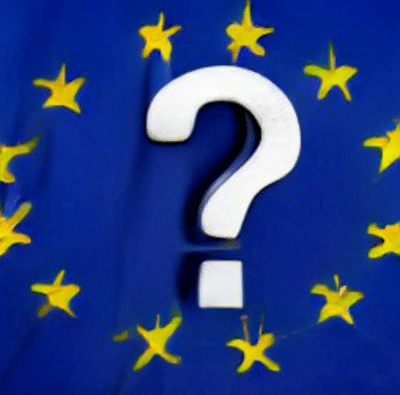To many, the difference between the European Council, the Council of the European Union, and the Council of Europe is not always very clear. While the first two are main EU institutions, the Council of Europe (CoE, 🔗 official website) is actually an independent larger international organization. To add to the confusion, the CoE is headquartered in Strasbourg in close proximity to the European Parliament and has partially adopted the EU flag in its logo.
To give you a better understanding, the European Union consists of the following seven main institutions:
- European Council: Taking decisions about the EU’s political direction, the European Council brings together the heads of state or government of every EU member state. (🔗 official website)
- Council of the European Union: Members of the European Union Council are government ministers from all member states. The Council plays an important role in the law-making process in the European Union and usually meets around specific policy areas. (🔗 official website)
- European Commission: The European Commission is the executive body of the European Union. (🔗 official website)
- European Parliament: The European Parliament is the direct representation of the European citizens and the central legislative body of the European Union. (🔗 official website).
- Court of Justice of the European Union (CJEU): It is the Court of Justice of the European Union that ensures that European law is interpreted and applied in every member state of the Union. (🔗 official website)
- Court of Auditors: The European Court of Auditors audits and supervises the accounts and budgets of the EU’s institutions. (🔗 official website)
- European Ombudsman: Throughout the European Union, the European Ombudsman ensures openness and accountability of administrations to protect the fundamental rights of citizens. (🔗 official website)
The EU Council
The European Council is the EU’s political body. As the Union’s main decision-making body, it sets the EU’s priorities and gives it political impetus on critical issues. As well as appointing the heads of the high constitutional institutions, the Council serves as general political orientation and external representation.
Because of its high-level work, monitoring the developments in the EU council was challenging and the Council is generally considered a “black hole”. With the integration of various Council document sources, policy-insider.ai provides detailed insights into the activities of the Council.
The Council of the European Union
The Council of the EU is one of the two legislative bodies of the European Union. It represents the governments of the Member States, which alternately hold its Presidency (🔗see calendar here). The Council plays an important role in EU decision-making. Legislative acts are usually negotiated and adopted through the ordinary legislative procedure in collaboration with the European Parliament.
If you need to monitor these institutions, remember:
Try it out for free here!
their websites are for citizens,
policy-insider is for professionals!
The Council of Europe (CoE)
The Council of Europe (CoE, 🔗 official website) is not an institution of the European Union but actually an independent larger international organization., headquartered in Strasbourg.
As a result of World War II, the Council of Europe was formed to promote human rights, democracy, and the rule of law throughout Europe. While not being part of the European Union, no country has joined the EU before joining the Council of Europe so far.

With 46 member states and a population of approximately 675 million, the organization was founded in 1949. It has an annual budget of approximately 500 million euros.
To make things even a little more complicated, the Council of Europe actually includes a parliamentary assembly, that is not to be confused with the European Parliament. The 306 members and their 306 substitutes are nominated by the national parliaments of the 46 member states (🔗 official website of the parliamentary assembly).
Member Overview
| Council of Europe | European Union | Eurogroup |
| Albania | ||
| Andorra | (Andorra) | |
| Armenia | ||
| Austria | Austria | Austria |
| Azerbaijan | ||
| Belgium | Belgium | Belgium |
| Bosnia and Herzegovina | ||
| Bulgaria | Bulgaria | |
| Croatia | Croatia | Croatia |
| Cyprus | Cyprus | Cyprus |
| Czech Republic | Czech Republic | |
| Denmark | Denmark | |
| Estonia | Estonia | Estonia |
| Finland | Finland | Finland |
| France | France | France |
| Georgia | ||
| Germany | Germany | Germany |
| Greece | Greece | Greece |
| Hungary | Hungary | |
| Iceland | ||
| Ireland | Ireland | Ireland |
| Italy | Italy | Italy |
| Latvia | Latvia | Latvia |
| Liechtenstein | ||
| Lithuania | Lithuania | Lithuania |
| Luxembourg | Luxembourg | Luxembourg |
| Malta | Malta | Malta |
| Moldova | ||
| Monaco | (Monaco) | |
| Montenegro | ||
| Netherlands | Netherlands | Netherlands |
| North Macedonia | ||
| Norway | ||
| Poland | Poland | |
| Portugal | Portugal | Portugal |
| Romania | Romania | |
| Russia | ||
| San Marino | (San Marino) | |
| Serbia | ||
| Slovakia | Slovakia | Slovakia |
| Slovenia | Slovenia | Slovenia |
| Spain | Spain | Spain |
| Sweden | Sweden | |
| Switzerland | ||
| Turkey | ||
| Ukraine | ||
| United Kingdom | ||
| 46 countries | 27 countries | 20+3 countries |
Additionally, the Vatican City, the United States, Canada, Japan, and Mexico have an Observer Status to the Council of Europe.


